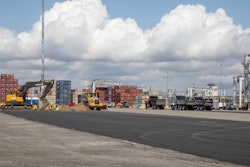
Nearshoring has gained significant attention as an innovative way for businesses to rethink operations while mitigating risk and increasing speed to market. What are the benefits and challenges for companies in the consumer packaged goods (CPG) space?
Nearshoring has been a hot topic, even rising to the stages of recent presidential debates in North America. As companies observe their peers relocating operations closer to home, one of the primary drivers of nearshoring to Mexico in 2024 is the suite of economic incentives and tax benefits introduced by the Mexican government. These measures are strategically designed to attract foreign direct investment (FDI) and bolster Mexico's competitive edge in the global market, while benefiting companies in the United States at the same time.
Why choose Mexico?
Mexico's proximity to the United States, which accounts for roughly 25% of the world's GDP, remains a crucial driver for nearshoring in 2024. This geographical advantage substantially reduces transportation costs and delivery times for companies serving North American markets. With over 50 border crossings along the 2,000-mile U.S./Mexico border, products can reach U.S. customers in 3-5 days, compared to the 15-50 days typically required for sea shipments from Asia. This supply chain optimization allows for faster and more flexible supply chains, which are essential to meet consumer demands in today’s age.
The United States-Mexico-Canada Agreement (USMCA) also plays a pivotal role in driving nearshoring activities in Mexico by providing businesses with tariff-free access to the US and Canadian markets. This enhances competitiveness and reduces operational costs. Since the USMCA's implementation, Mexico has become the primary trading partner for the United States. In 2022, Mexico's exports to North America comprised ~80% of its total global exports, a proportion that increased to ~85% during January to September 2023. Additionally, in 2023, Mexico emerged as the United States’ leading export partner, with exports amounting to $476 billion, surpassing China which experienced a 20% year-on-year decline in exports to the US during the same period.
This upward trend in Mexico’s exports is expected to continue due to strong U.S. market demand and favorable USMCA conditions.
Companies in the United States are also often looking to reduce dependence on China amid recent developments. The UMSCA agreement has strategically reduced the United States’ reliance on Chinese imports, positioning Mexico as a preferred alternative for manufacturing and supply chain operations.
Managing global risk
Global supply chains have faced severe disruptions due to geopolitical events like the COVID-19 pandemic, the Russia-Ukraine war, and the Israel-Hamas war. In 2023 and 2024, attacks on commercial ships in the Red Sea have disrupted vital sea-based shipping lanes, and six of the Top 10 container carriers have diverted their routes away from the Red Sea, impacting an estimated 62% of global shipping capacity.
These crises have increased delivery lead times and created raw material and ingredient shortages, highlighting the urgency for supply chain resilience and diversification. Mexico’s proximity to the United States, coupled with its stable political environment, provides a strategic advantage for companies aiming to reduce risks associated with geopolitical instability.
Several CPG companies are already seizing this growing opportunity. For instance, in 2024, Nestlé Purina announced a strategic investment of $220 million to expand its plant in Silao, Guanajuato, aiming to significantly enhance its manufacturing capabilities in Mexico and reduce reliance on imports.
Adopting nearshoring as a strategy can also mitigate risks associated with long-distance supply chains, such as delays, increased transportation costs, and difficulties with quality control and regulatory compliance.
Strategies for companies navigating nearshoring
Whether you’re nearshoring or offshoring, the most fundamental aspect has not changed: make sure your company is selecting the right supplier partner. Additionally, it’s important to note the need for a diverse supplier base and avoiding sole-supplier situations. Building close relationships with a focused set of strategic suppliers in the nearshore destination, will enable stronger supply chains.
With closer collaboration, companies can also establish firmer quality control procedures jointly with their suppliers, as they have the ability to be more involved in production. Regular communication allows for real-time feedback and quicker identification of any quality issues during production. The physical closeness of nearshore suppliers also enables faster on-site visits and faster resolution of quality problems and ensuring consistently high-quality products.
Having a set of mutually agreed-upon performance goals is crucial. When buyers and suppliers work together and share data, insights, and ideas, risks decrease, and new opportunities for innovation are uncovered. Maintaining close relationships also allows suppliers to collaborate in supply chain planning, and projects related to sustainability.
The adoption of an analytics-driven supply chain monitoring process will also be key when navigating nearshoring for your organization. Having access to ongoing insights into suppliers of suppliers and emerging demand-supply situations allows companies to see the bigger picture, analyze details, and take appropriate action in a timely manner. Organizations using analytics-driven solutions are generally more successful in managing supply chain disruptions, as they have the data to back up their decisions. This data can also serve as a valuable asset for long-term planning, enabling businesses to create sustainable and adaptable models for the future. These strategies ensure that companies remain agile, adapting swiftly to market changes and maintaining continuity of operations. Moreover, embracing technology and automation can further enhance the efficiency and reliability of nearshored supply chains.
Taking action
Overall, CPG companies should consider nearshoring as a strategic approach for their operations. By leveraging Mexico's proximity, skilled workforce, and favorable trade agreements, businesses can create more resilient and responsive operations. As the global landscape continues to evolve, nearshoring is poised to play an even greater role in the future of supply chain success on a global scale. By embracing a nearshoring strategy, CPG companies can ensure they remain competitive and adaptable in an ever-changing global market.




















